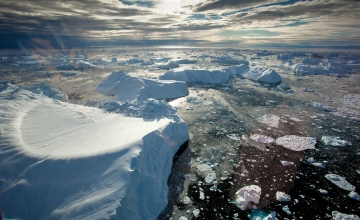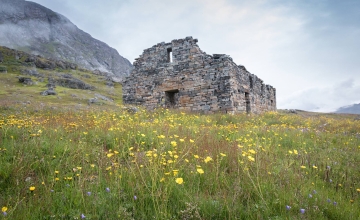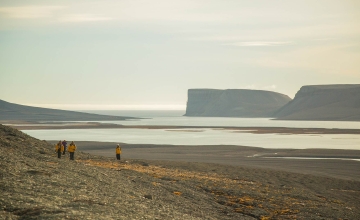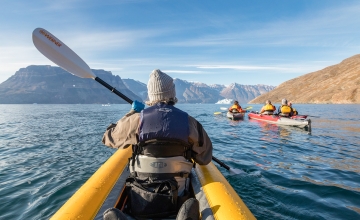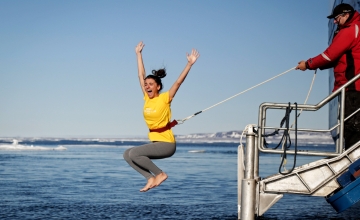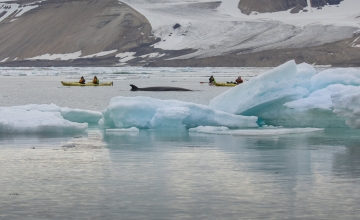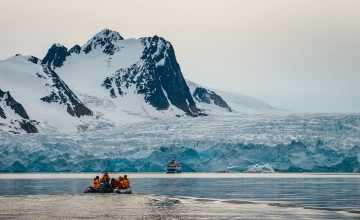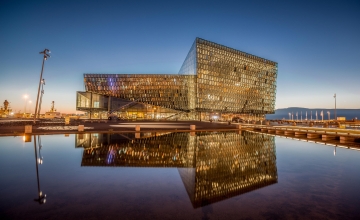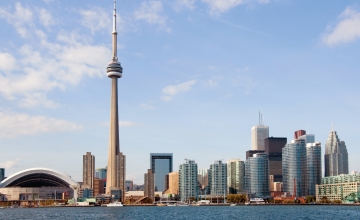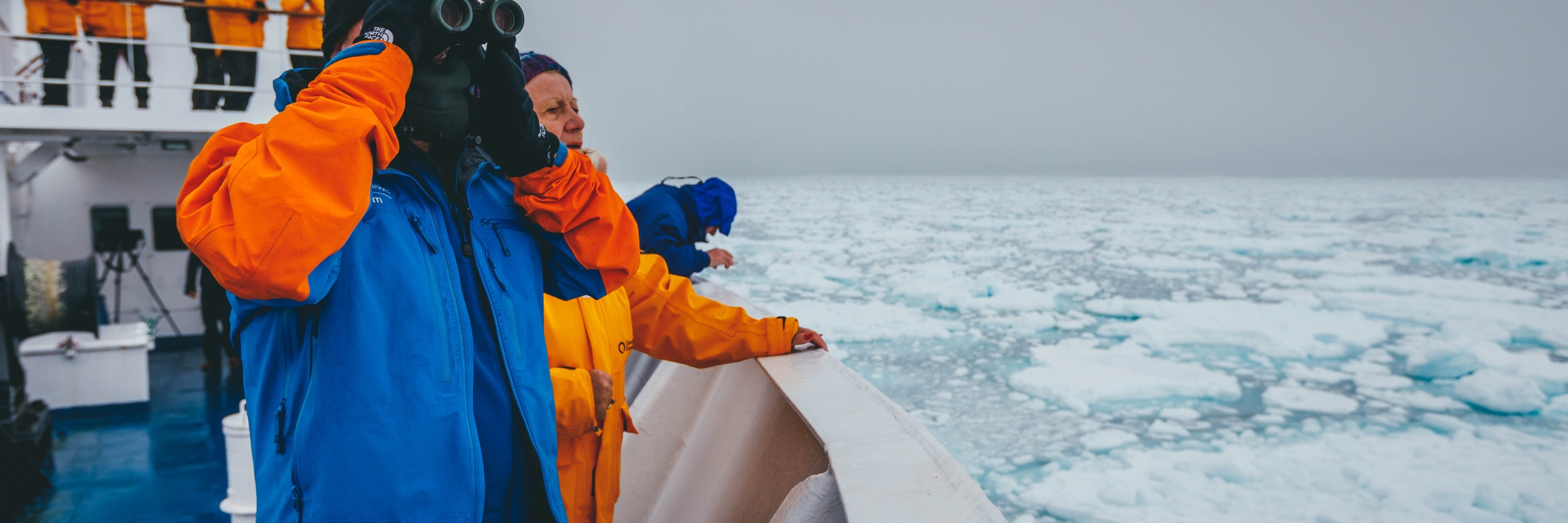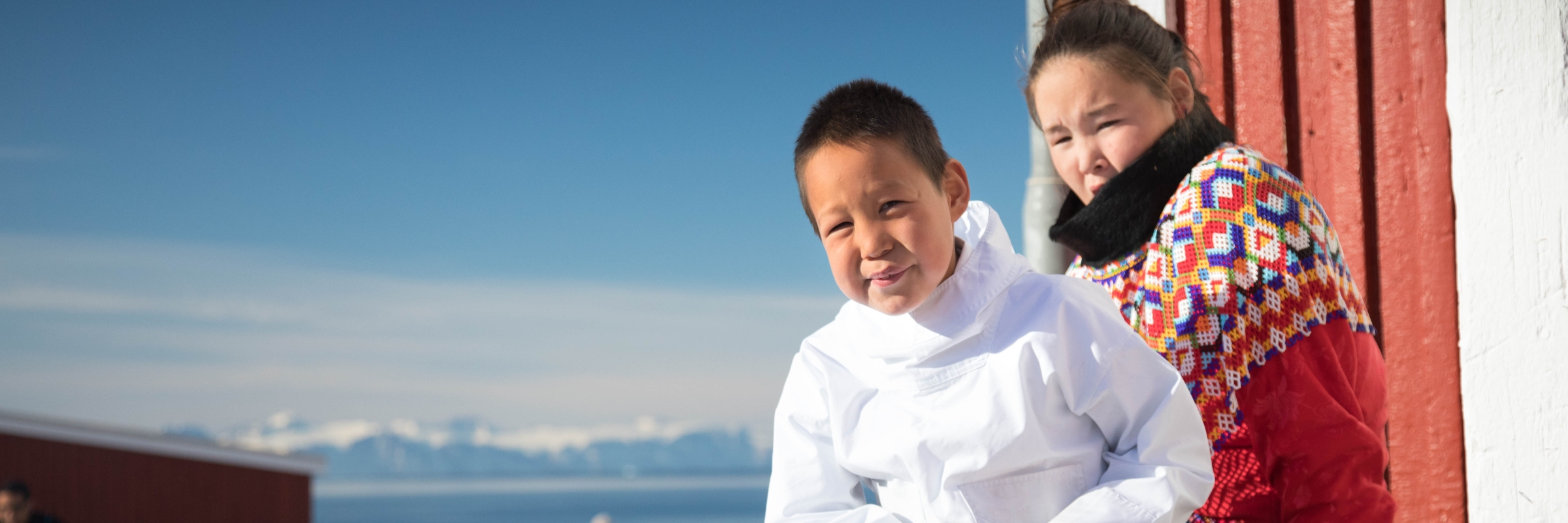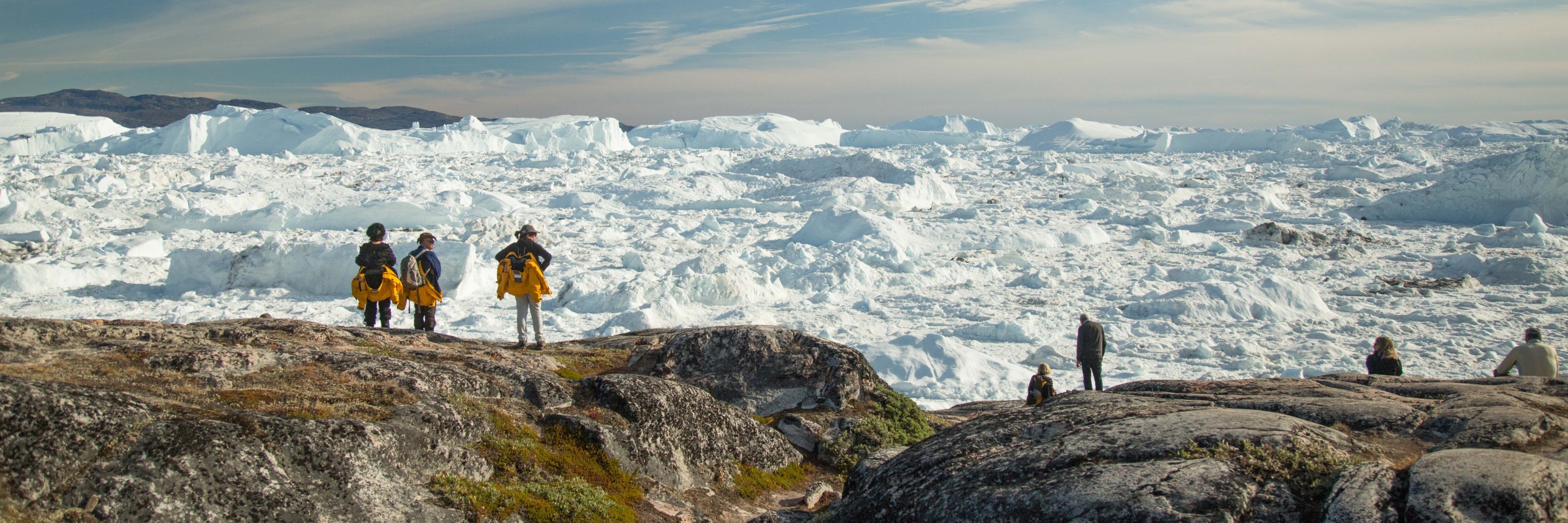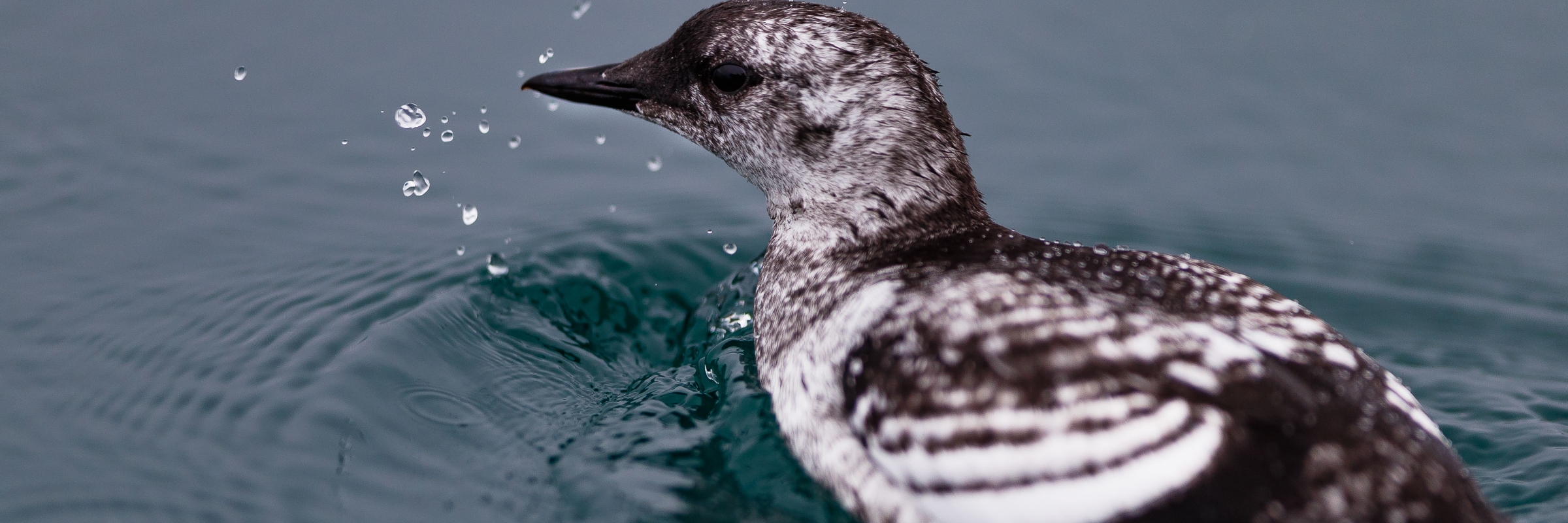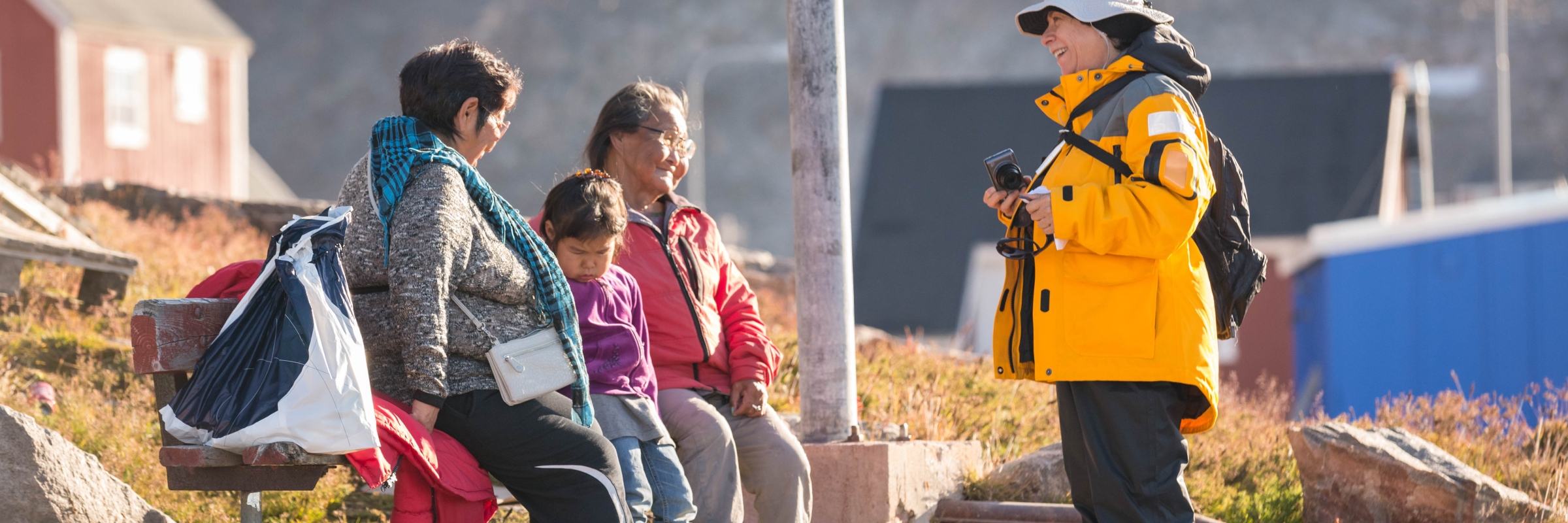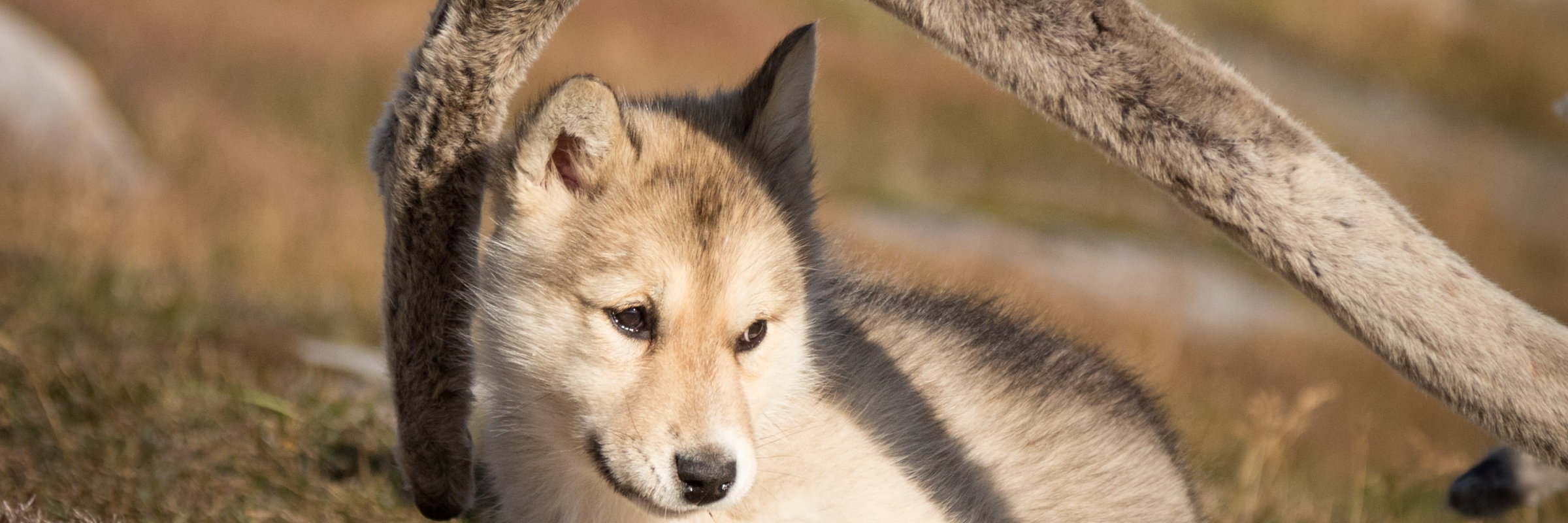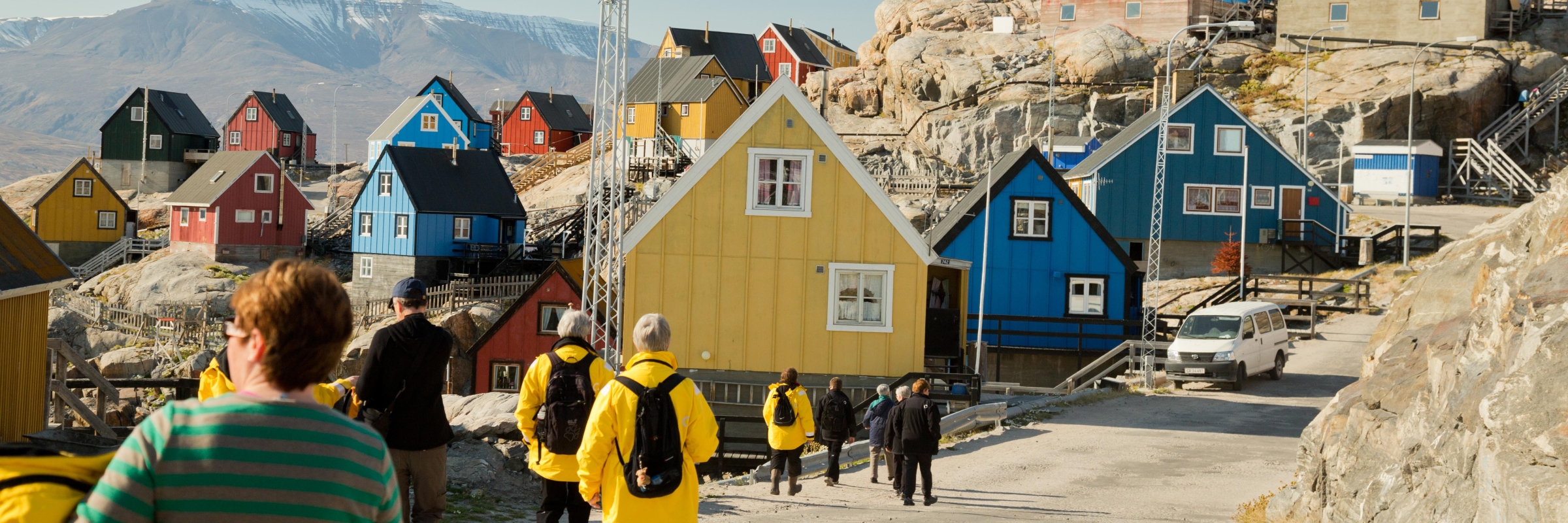Your Arctic expedition begins in Toronto. Explore this vibrant city on your own before spending the night at your well-appointed hotel.
Best of the Western Arctic: Canada and Greenland
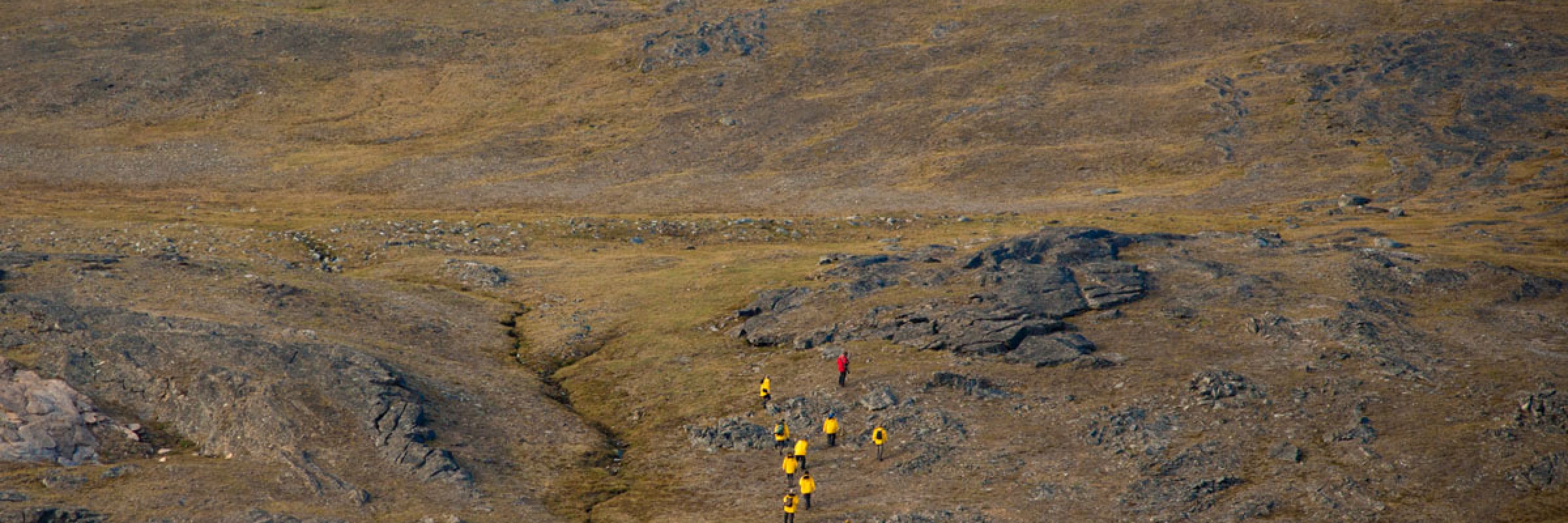
On the Best of the Western Arctic: Canada and Greenland itinerary, you’ll explore the northerly shores of Canada’s Baffin Island and the western coast of Greenland, visiting local communities and searching for wildlife that inhabit this remote, mysterious realm. Zodiac cruising will give you one-of-a-kind perspectives of icebergs, glaciers and fjords. Community visits will reward you with insights into traditional and modern ways of life in the Western Arctic, and the rugged beauty of these pristine landscapes will leave you breathless, whether it’s the soaring cliffs of Sam Ford Fjord or the sculpted icebergs that dominate the Ilulissat Icefjord. In a wildlife-rich region such as this, it’s quite possible you’ll spot whales or catch a glimpse of one of the Arctic’s most iconic animals—the polar bear.
The Arctic has been inspiring explorers for centuries, and our expeditions offer the chance for you to discover why. We’re excited to host you on your unforgettable adventure! Feel free to reach out to our team of Polar Travel Advisers or your travel professional, who can answer your questions and provide assistance at any time.
- Search for iconic arctic wildlife, such as polar bears, muskoxen, walrus and whales
- Explore Canadian wildlife sanctuaries and the Ilulissat Icefjord, a UNESCO World Heritage Site
- Visit traditional settlements and meet Inuit and Greenlandic locals
- Cruise in a Zodiac to explore icebergs, glaciers, fjords and more
- Immerse yourself in the icy realm of the Arctic with optional kayaking adventures
行程
Day 1 — Arrive in Toronto, Canada
Day 2 — Embarkation Day in Kangerlussuaq, Greenland and Embark
This morning, board your charter flight to Kangerlussuaq, a small town at the eastern head of Kangerlussuaq Fjord, one of the longest fjords in the world. After embarking your ship in the afternoon, enjoy time out on deck, taking in your new surroundings as you set sail on your Arctic expedition.
Day 3 — At Sea
As we cruise across the Davis Strait, your Expedition Team will prepare you for the adventures that await. Learn about the storied history and politics of the Arctic, its fascinating wildlife, geology, ecology and climate, and the incredible sights you will soon explore. Staff will also keep a lookout for seabirds soaring above your ship, as well as whales that pass through these waters.
Exploring the remote regions of Greenland and the Canadian Arctic aboard Ultramarine, the newest ship in our fleet, you’ll navigate the same icy inlets, channels and bays that
fascinated legendary explorers of long ago. Designed to give polar adventurers unprecedented access to the hardestto-reach places on the planet—and equipped with two onboard twin-engine helicopters for unparalleled access to areas only Quark Expeditions can bring you—this one-of-a-kind ship will take you beyond the familiar in polar exploration. Throughout your journey, your Expedition Team will keep an eye toward immersing you in the best the Arctic has to offer at the top of the world.
Days 4 to 6 — Exploring Baffin Island, Canada
Baffin Island is the fifth-largest island in the world. Its Inuktitut name is Qikiqtaaluk, and it has been home to Inuit for thousands of years. The colonial name Baffin Island comes from English navigator William Baffin, who ventured to the area in the early 17th century in search of the fabled Northwest Passage. Your days sailing along the island’s eastern coast will be guided by weather and ice conditions, with each day and each landing presenting new adventures. Some of our favorite destinations include Qikiqtarjuaq and Isabella Bay. Towering mountains, deep fjords, colorful tundra, and Inuit settlements await!
The Inuit community of Qikiqtarjuaq (which means “the big island” in Inuktitut) is located just north of the Arctic Circle, on Broughton Island. Fondly called Qik by locals, the welcoming hamlet offers a superb vantage point of the Davis Strait. You’ll also have a chance to support local Inuit artisans here by purchasing unique artwork, crafts and jewelry.
Cruising farther north along the east coast of Baffin Island, we’ll approach Isabella Bay, an important summer and fall feeding area for a large population of bowhead whales.
Day 7 — At Sea
As our ship sails farther north, take in a presentation by our on-board experts, sip a cocktail in the bar, watch a documentary film or join your Expedition Team on the bridge as they scan for wildlife—there is no shortage of activities while at sea.
Days 8 to 11 — Lancaster Sound
The gateway to the Northwest Passage, Lancaster Sound (Tallurutiup Imanga) is one of the richest marine habitats in the Arctic. With open-water areas staying ice-free all year, it is an important summer feeding area for whales and other marine wildlife. Our days here will be spent exploring several of the sound’s beautiful bays and inlets, discovering historical sites, enjoying Zodiac cruises and searching for such iconic wildlife as walrus, seals and, of course, whales. Polar bear sightings are possible too, as Lancaster Sound is known for polar bear sightings. If you’re fortunate, you may even spot the elusive narwhal.
There may be a possibility for a shore visit at Radstock Bay, the location of one of the most impressive ancient Thule sites in the Arctic. Exploring the well-preserved remains of the subterranean houses, including the whale bones used as supports for the dwellings, will give you an understanding of how these pre- Inuit people thrived in the Far North.
We will attempt to land at Beechey Island, a Canadian National Historic Site. Named after explorer Frederick William Beechey, the island is the final resting place of three members of Sir John Franklin’s 1845–46 expedition to find the Northwest Passage. The graves, on a desolate rocky raised beach, were discovered in 1850 by a search party looking for signs of the ill-fated expedition.
Predominantly covered in glaciers and ice fields, Coburg Island and its surrounding waters comprise the Nirjutiqavvik National Wildlife Area. The island’s steep coastal cliffs are an ideal habitat for hundreds of thousands of nesting seabirds like Brünnich’s guillemots (thick-billed murres), blacklegged kittiwakes, northern fulmars and black guillemots.
Day 12 — Smith Sound
Before saying goodbye to Nunavut, we’ll push as far north as possible, exploring both sides of Smith Sound, the uninhabited passage between Ellesmere Island and Greenland. Experience a true expedition as weather and ice determine how far north we explore.
Days 13 and 14 — Exploring Northwest Greenland
Your return to Greenland will have you sailing along the remote northwest coast, a land of impressive icebergs and massive glaciers. Qaanaaq, formerly known as Thule, is one of the northernmost towns in the world. Here, local Inuit share their culture and traditions, while the museum sheds more light on life near the top of the world.
We hope to explore Melville Bay, a significant whaling site until the early 1900s. Opening up to Baffin Bay, the area is a major egress for the Greenland ice cap and is home to spectacular icebergs in all shapes and sizes, making it an ideal spot for Zodiac cruising. If you’re feeling adventurous, perhaps you’ll treat yourself to a unique Arctic experience by partaking in an optional paddling excursion (additional cost).
Day 15 — At Sea
As we continue sailing south along the west coast of Greenland, presentations by our on-board experts will prepare you for the adventures that lie ahead.
Days 16 to 18 — Exploring West Greenland
Boasting spectacular glaciers, mountainous landscapes, dramatic fjords and vibrant communities, the west coast of Greenland will leave you breathless. Some areas we hope to explore here are Uummannaq, Itilleq and the impressive Ilulissat Icefjord.
Quite possibly the most picturesque place in Greenland, the traditional Inuit town of Uummannaq (which means “heart-like”) takes its name from the red heart-shaped mountain that rises up a staggering 3,840 feet (1,170 meters) behind it. You’ll want to be positioned on deck as your ship approaches the shore, with your camera ready to capture the inspiring vistas of the twin peaks soaring high above the colorful houses dotting the rugged coastline.
Another beautiful locale is the Ilulissat Icefjord, a UNESCO World Heritage Site, an absolutely unique glacial phenomenon found nowhere else in the world. Home to Sermeq Kujalleq, one of the most active glaciers in the world, this is a great spot to enjoy a Zodiac excursion past towering icebergs. Venturing ashore in the town of Ilulissat (which means “iceberg”) will allow you to visit the icefjord on foot and gaze at this unforgettable river of ice from the rocky shore.
Surrounded by sea and mountains, Itilleq is situated about a mile (2 km) above the Arctic Circle, in a scenic hollow on a small island. It is the southern limit of the Greenlandic sled dog. To keep the breed pure, the dogs are not permitted south of this community and all other dog breeds are prohibited this far north. It’s also known as a welcoming community, where you might experience “kaffemik,” a Greenlandic tradition of inviting visitors in for coffee, cakes and conversation. Explore the town’s charming wooden houses painted in a rainbow of colors, chat with the locals, whose main trade is fishing, and maybe challenge them to a game of football (soccer) —it won’t be long before you’re experiencing Itilleq’s famous friendly vibe.
Day 19 — Disembark in Kangerlussuaq and Fly to Toronto
Enjoy one more Zodiac ride to shore, where you’ll board your charter flight back to Toronto, Canada. Upon arrival in Toronto, we will transfer you to your included hotel.
Day 20 — Depart Toronto, Canada
Today, you can make your way home at your leisure or spend time exploring this fascinating city.
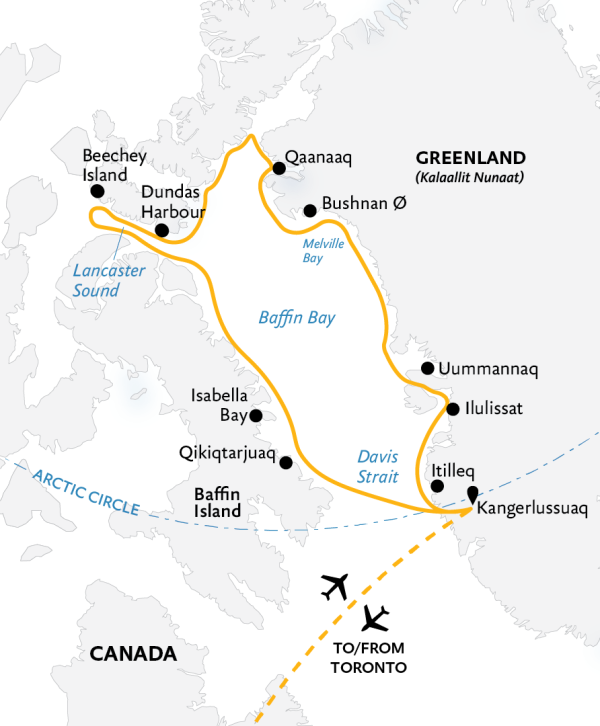
Day 1 — Arrive in Toronto, Canada
Your Arctic expedition begins in Toronto. Explore this vibrant city on your own before spending the night at your well-appointed hotel.
Day 2 — Embarkation Day in Kangerlussuaq, Greenland and Embark
This morning, board your charter flight to Kangerlussuaq, a small town at the eastern head of Kangerlussuaq Fjord, one of the longest fjords in the world. After embarking your ship in the afternoon, enjoy time out on deck, taking in your new surroundings as you set sail on your Arctic expedition.
Day 3 — At Sea
As we cruise across the Davis Strait, your Expedition Team will prepare you for the adventures that await. Learn about the storied history and politics of the Arctic, its fascinating wildlife, geology, ecology and climate, and the incredible sights you will soon explore. Staff will also keep a lookout for seabirds soaring above your ship, as well as whales that pass through these waters.
Exploring the remote regions of Greenland and the Canadian Arctic aboard Ultramarine, the newest ship in our fleet, you’ll navigate the same icy inlets, channels and bays that fascinated legendary explorers of long ago. Designed to give polar adventurers unprecedented access to the hardest-to-reach places on the planet—and equipped with two onboard twin-engine helicopters for unparalleled access to areas only Quark Expeditions can bring you—this one-of-a-kind ship will take you beyond the familiar in polar exploration. Throughout your journey, your Expedition Team will keep an eye toward immersing you in the best the Arctic has to offer at the top of the world
Days 4 to 6 — Exploring Baffin Island, Canada
Baffin Island is the fifth-largest island in the world. Its Inuktitut name is Qikiqtaaluk, and it has been home to Inuit for thousands of years. The colonial name Baffin Island comes from English navigator William Baffin, who ventured to the area in the early 17th century in search of the fabled Northwest Passage. Your days sailing along the island’s eastern coast will be guided by weather and ice conditions, with each day and each landing presenting new adventures. Some of our favorite destinations include Qikiqtarjuaq and Isabella Bay. Towering mountains, deep fjords, colorful tundra, and Inuit settlements await!
The Inuit community of Qikiqtarjuaq (which means “the big island” in Inuktitut) is located just north of the Arctic Circle, on Broughton Island. Fondly called Qik by locals, the welcoming hamlet offers a superb vantage point of the Davis Strait. You’ll also have a chance to support local Inuit artisans here by purchasing unique artwork, crafts and jewelry.
Cruising farther north along the east coast of Baffin Island, we’ll approach Isabella Bay, an important summer and fall feeding area for a large population of bowhead whales.
Day 7 — Cruising
As our ship sails farther north, take in a presentation by our on-board experts, sip a cocktail in the bar, watch a documentary film or join your Expedition Team on the bridge as they scan for wildlife—there is no shortage of activities while at sea.
Days 8 to 11 — Lancaster Sound
The gateway to the Northwest Passage, Lancaster Sound (Tallurutiup Imanga) is one of the richest marine habitats in the Arctic. With open-water areas staying ice-free all year, it is an important summer feeding area for whales and other marine wildlife. Our days here will be spent exploring several of the sound’s beautiful bays and inlets, discovering historical sites, enjoying Zodiac cruises and searching for such iconic wildlife as walrus, seals and, of course, whales.
Polar bear sightings are possible too, as Lancaster Sound is known for polar bear sightings. If you’re fortunate, you may even spot the elusive narwhal.
There may be a possibility for a shore visit at Radstock Bay, the location of one of the most impressive ancient Thule sites in the Arctic. Exploring the well-preserved remains of the subterranean houses, including the whale bones used as supports for the dwellings, will give you an understanding of how these pre-Inuit people thrived in the Far North.
We will attempt to land at Beechey Island, a Canadian National Historic Site. Named after explorer Frederick William Beechey, the island is the final resting place of three members of Sir John Franklin’s 1845–46 expedition to find the Northwest Passage. The graves, on a desolate rocky raised beach, were discovered in 1850 by a search party looking for signs of the ill-fated expedition.
Predominantly covered in glaciers and ice fields, Coburg Island and its surrounding waters comprise the Nirjutiqavvik National Wildlife Area. The island’s steep coastal cliffs are an ideal habitat for hundreds of thousands of nesting seabirds like Brünnich’s guillemots (thick-billed murres), black-legged kittiwakes, northern fulmars and black guillemots.
Day 12 — Smith Sound
Before saying goodbye to Nunavut, we’ll push as far north as possible, exploring both sides of Smith Sound, the uninhabited passage between Ellesmere Island and Greenland. Experience a true expedition as weather and ice determine how far north we explore.
Days 13 and 14 — Exploring Northwest Greenland
Your return to Greenland will have you sailing along the remote northwest coast, a land of impressive icebergs and massive glaciers. Qaanaaq, formerly known as Thule, is one of the northernmost towns in the world. Here, local Inuit share their culture and traditions, while the museum sheds more light on life near the top of the world.
We hope to explore Melville Bay, a significant whaling site until the early 1900s. Opening up to Baffin Bay, the area is a major egress for the Greenland ice cap and is home to spectacular icebergs in all shapes and sizes, making it an ideal spot for Zodiac cruising. If you’re feeling adventurous, perhaps you’ll treat yourself to a unique Arctic experience by partaking in an optional paddling excursion (additional cost).
Day 15 — At Sea
As we continue sailing south along the west coast of Greenland, presentations by our on-board experts will prepare you for the adventures that lie ahead.
Days 16 to 18 — Exploring West Greenland
Boasting spectacular glaciers, mountainous landscapes, dramatic fjords and vibrant communities, the west coast of Greenland will leave you breathless. Some areas we hope to explore here are Uummannaq, Itilleq and the impressive Ilulissat Icefjord.
Quite possibly the most picturesque place in Greenland, the traditional Inuit town of Uummannaq (which means “heart-like”) takes its name from the red heart-shaped mountain that rises up a staggering 3,840 feet (1,170 meters) behind it. You’ll want to be positioned on deck as your ship approaches the shore, with your camera ready to capture the inspiring vistas of the twin peaks soaring high above the colorful houses dotting the rugged coastline.
Another beautiful locale is the Ilulissat Icefjord, a UNESCO World Heritage Site, an absolutely unique glacial phenomenon found nowhere else in the world. Home to Sermeq Kujalleq, one of the most active glaciers in the world, this is a great spot to enjoy a Zodiac excursion past towering icebergs. Venturing ashore in the town of Ilulissat (which means “iceberg”) will allow you to visit the icefjord on foot and gaze at this unforgettable river of ice from the rocky shore.
Surrounded by sea and mountains, Itilleq is situated about a mile (2 km) above the Arctic Circle, in a scenic hollow on a small island. It is the southern limit of the Greenlandic sled dog. To keep the breed pure, the dogs are not permitted south of this community and all other dog breeds are prohibited this far north. It’s also known as a welcoming community, where you might experience “kaffemik,” a Greenlandic tradition of inviting visitors in for coffee, cakes and conversation. Explore the town’s charming wooden houses painted in a rainbow of colors, chat with the locals, whose main trade is fishing, and maybe challenge them to a game of football (soccer) —it won’t be long before you’re experiencing Itilleq’s famous friendly vibe.
Day 19 — Disembark in Kangerlussuaq and Fly to Toronto
Enjoy one more Zodiac ride to shore, where you’ll board your charter flight back to Toronto, Canada. Upon arrival in Toronto, we will transfer you to your included hotel.
Day 20 — Depart Toronto, Canada
Today, you can make your way home at your leisure or spend time exploring this fascinating city.

